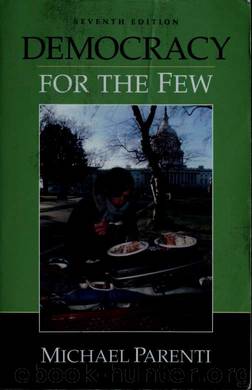Democracy for the few by Michael Parenti

Author:Michael Parenti
Language: eng
Format: epub
Tags: Elite (Social sciences) -- United States, Political participation -- United States, United States -- Politics and government -- 1945-1989, United States -- Politics and government -- 1989-
Publisher: Bedford/St. Martin's
Published: 2002-02-27T16:00:00+00:00
Labor Besieged
Some political science textbooks juxtapose “Big Labor” with Big Business, thereby leaving the impression that political power is pluralistically distributed among countervailing forces. In reality, government has historically been friendly to business and hostile to labor. Historically, the capitalist state's raison d'etre is to secure the interests of the wealthy propertied class. State security agencies such as the Federal Bureau of Investigation (FBI) have a history of spying on unions, sometimes in cooperation with management.11 While labor can sometimes play an effective role in support of social legislation, it usually cannot match business in material resources and political muscle. Total corporate profits are hundreds of times greater than the total income of labor unions. And few if any labor leaders are given top decision-making posts in government.
Corporate spokespersons tell us that labor unions are corrupt, unpopular, harmful, and too powerful. The truth is something else. In 1935, working people won a major victory when a federal law was passed setting up the National Labor Relations Board (NLRB) as an independent federal agency intended to protect labors right to collective bargaining. In the years that followed, union membership increased dramatically and workers across the country 7 made wage gains amounting to billions of dollars. Then, in 1947, a Republican-controlled Congress passed the Taft-Hartley Act, which imposed restrictions on strikes, bovcotts, and labor organizing, leading to a decline in union membership from 35 percent of the workforce to about 14 percent by 2000. If we don't count public employees and consider only the private sector, union membership is only 10.2 percent, lower than it was in 1932 before the New Deal.12
More than a thousand consulting firms doing a $500-million yearly business teach companies how to prevent workers from organizing and how to get rid of existing unions. During union election drives, management can interfere in the organizing process, propagandizing workers as a captive audience, and plying them with gifts and promises in order to induce an anti-union vote. In contrast, union organizers are prohibited from giving gifts to workers and denied access to the worksite. Management can threaten to move the plant if a union is voted in. Workers are frequently and unlawfully fired for attempting to organize, although management always gives other reasons, such as “poor performance.” The NLRB follows the rule that if there is any business reason for firing a worker unrelated to union activity then termination is legal.13
Bosses can use NLRB procedures to delay elections for months, even years. When unions do win recognition, management may refuse to negotiate a contract and will challenge the election results in the courts. The NLRB will sometimes spend years investigating minor or frivolous management charges. By the time the company is ordered to bargain, many union supporters may have quit or been fired, while new employees are being screened for union sympathy. And after bargaining begins, the company still can resist reaching an acceptable contract agreement.14
Sometimes management may refuse to renew an existing contract when it expires. It may deliberately close its doors, forcing workers out in what is known as a “lockout.
Download
This site does not store any files on its server. We only index and link to content provided by other sites. Please contact the content providers to delete copyright contents if any and email us, we'll remove relevant links or contents immediately.
| Anarchism | Communism & Socialism |
| Conservatism & Liberalism | Democracy |
| Fascism | Libertarianism |
| Nationalism | Radicalism |
| Utopian |
The Secret History by Donna Tartt(16718)
The Social Justice Warrior Handbook by Lisa De Pasquale(11506)
Thirteen Reasons Why by Jay Asher(7831)
This Is How You Lose Her by Junot Diaz(5827)
Weapons of Math Destruction by Cathy O'Neil(5078)
Zero to One by Peter Thiel(4867)
The Myth of the Strong Leader by Archie Brown(4809)
Promise Me, Dad by Joe Biden(4478)
Beartown by Fredrik Backman(4464)
How Democracies Die by Steven Levitsky & Daniel Ziblatt(4447)
Stone's Rules by Roger Stone(4438)
The Fire Next Time by James Baldwin(4371)
100 Deadly Skills by Clint Emerson(4106)
A Higher Loyalty: Truth, Lies, and Leadership by James Comey(4059)
Rise and Kill First by Ronen Bergman(4043)
The David Icke Guide to the Global Conspiracy (and how to end it) by David Icke(3913)
The Farm by Tom Rob Smith(3894)
Secrecy World by Jake Bernstein(3806)
The Doomsday Machine by Daniel Ellsberg(3758)
